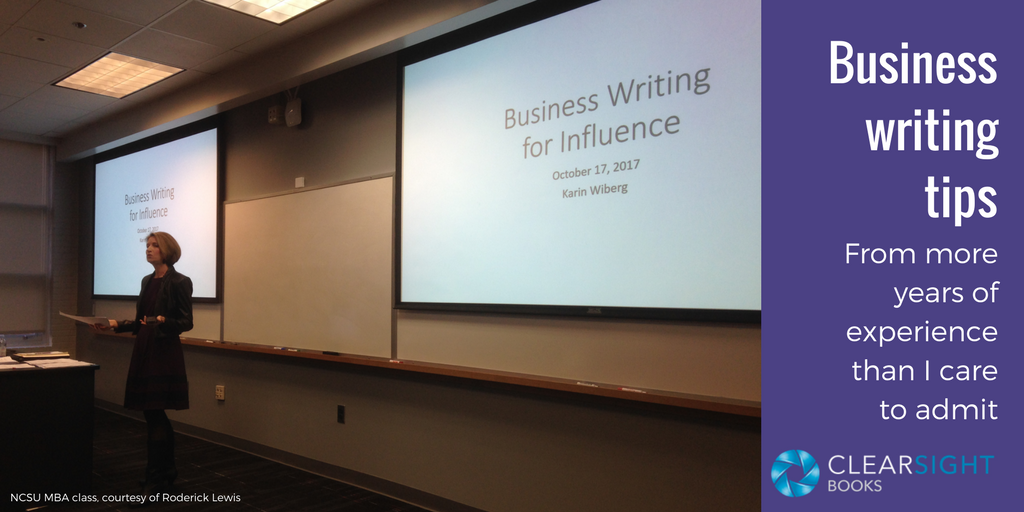 Lately I’ve been fielding invitations to speak about general business writing—from talking with an NC State MBA class about making a strong business case to speaking with nonprofit arts organizations about writing strong grant applications. I realized I have some common principles for business writing that I consistently offer as feedback.
Lately I’ve been fielding invitations to speak about general business writing—from talking with an NC State MBA class about making a strong business case to speaking with nonprofit arts organizations about writing strong grant applications. I realized I have some common principles for business writing that I consistently offer as feedback.
First and foremost, whether you’re writing a recommendation, a grant narrative, or a project status report, make it as easy as possible for the reader. I offer the following business writing tips in support of that objective.
Choose clarity over beauty
Your top priority in written business communications is to provide clear, complete information. If you happen to be a good writer and can make the words pretty, fantastic; do that second—if you have time and it’s important. “Pretty” might be important if you’re writing marketing copy or the next great American novel, but not for most business writing. (Can you believe I said that? And I’m a poet!)
Be thorough
Provide all the information your audience needs and expects. If you are writing a grant application, answer all the questions. For a business case, fill out your company’s template completely. When you can predict an obvious question, be sure to include the answer.
Provide context
It can be tempting to load up your readers with data—whether financials, system up-time metrics, or lists of other nonprofits you’ve collaborated with. While you do need to provide data, what’s often more important is that you interpret that data. What’s the story behind the financials? Why aren’t we hitting our system up-time goals? If it’s important for me to know you collaborated with other nonprofits, don’t just list them; tell me how it benefited your constituents.
Be concise
Use as many words as you need and no more. (Shall I stop there?) The admonition “be concise” may seem at odds with “be thorough.” It’s not, but it does take practice to find the right balance. Circulating advance drafts to peers or key decision makers can help find that balance. Tip: If only a small minority of your audience needs certain information, place it in an appendix.
Eliminate distractions
Do not give your readers a chance to get distracted. Do not offer anything that leads them down a rabbit hole or that causes them to argue with immaterial points. (Material issues that require discussion are a different matter entirely.)
Avoid these distraction-rich areas:
- Inconsistencies (This tends to happen when you copy/paste from prior documents.)
- Interesting but unnecessary information (“Incidentally, did you know…”)
- Unneeded opinion (“Personally I prefer…”)
- Unsubstantiated claims (“This will help us get thousands of new clients—I promise!”)
- Absolute statements (Words like “always” or “never” can be a clue you are about to start an argument with your reader.)
- Personal comments (“BTW great to see you and the kids at the game Friday!”)
- Typos and noticeable mechanical errors, e.g., grammar, usage, punctuation (Notice my word “noticeable.” We all make mistakes; just don’t be gratuitous about it.)
Format for easy reading
Help your readers by making your document scannable and easy to read. Use:
- “Chunked” information – Each piece of information has a function or purpose, for example, financial metrics, process steps, pros/cons, definitions. Separate information by purpose, and group similar information together.
- Headings – Label sections of your document and format your headings to stand out, e.g., use bold or another formatting element. Write headings that are clear and meaningful. Provide your readers easy-to-scan document headings so they get an idea what the document covers and where to find specific information.
- White space/short paragraphs – Using white space and writing short paragraphs offers readers visual rest and allows faster scanning.
- Bulleted or numbered lists – Use bullets for lists of nonsequential items; use numbered lists for sequential steps or lists of items that require easy reference.
- Charts and tables – Charts and tables can pack a lot of information into a small space—as long as they have clear, precise labels so readers can understand them without having to search for explanation.
Applying these principles allows you to lead your readers through the information they need in an efficient and effective way. And, yes, the principles apply to books as well, though if you’re writing a book, I’d like some pretty language too…

